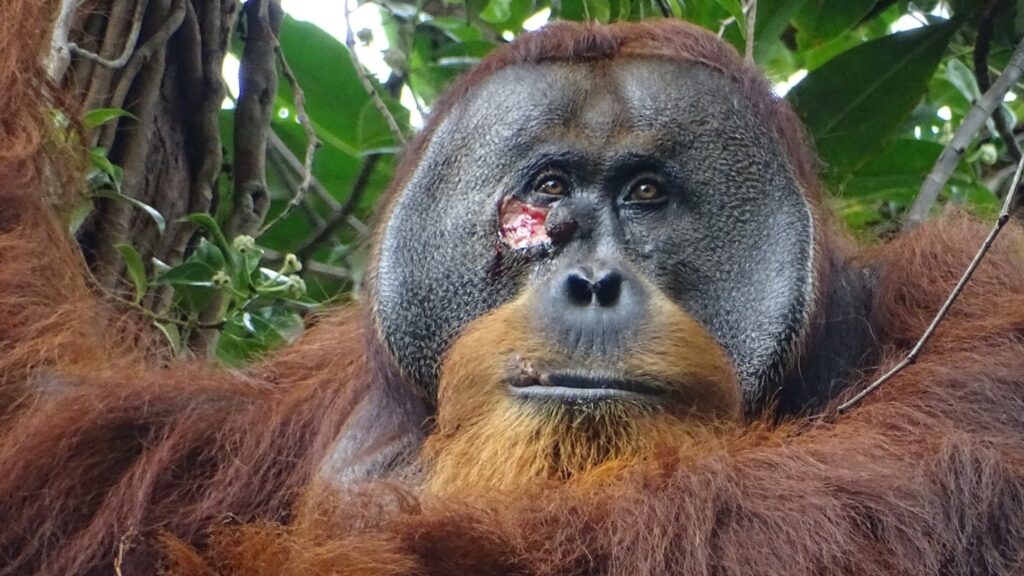When male Sumatran orangutans let out a long call, they’re usually trying to grab female attention. But the sounds — a booming blend of roars and grunts — can end up attracting unwanted attention from other males, too. Things can get tense. Which is likely how Rakus, an adult male orangutan frequently seen in Gunung Leuser National Park in South Aceh, Indonesia, acquired a face wound in June 2022.
What followed was a never-before-observed example of a wild animal treating its own wound with a substance showing medical properties, detailed in a new paper published Thursday in Nature.
advertisement
A few days after getting hurt, Rakus picked some leaves off a vine known as Akar Kuning that is abundant in parts of East and Southeast Asia. After chewing on them for about half an hour, he applied some of the plant’s juice directly to the wound, repeating the application over the course of seven minutes. At the very end of this process, he applied more solid plant material on the wound, like a kind of plaster.
He continued feeding on the plant in the following days, which he also dedicated to more rest than usual — sleeping about half of the time. The wound didn’t appear to get infected, and in a couple of days, it had healed entirely.
In a stroke of scientific luck, Rakus wasn’t alone in the forest: He was being observed by a team in the park’s Suaq Balimbing research area. Scientists there study the area’s Sumatran orangutans, monitoring and logging their activities for 12 hours a day, and have known Rakus, whom they estimate is in his mid-to-late 30s, since 2009.
advertisement
“We rarely observe injured orangutans,” said Isabelle Laumer, a cognitive biologist at the Max Planck Institute of Animal Behavior in Germany and the paper’s lead author. They don’t actually fight a lot, thanks to high food availability and what Laumer calls “social tolerance” between the apes. So researchers “need to be quite lucky to be at the right time, at the right place,” she said.
Such was the fortune of Arif Rahman, a biologist at the Universitas Nasional of Jakarta, Indonesia, and co-author of the paper. Rahman, who was part of the daily observation team, noticed the wound and kept detailed logs of Rakus’ behavior through the self-healing process, noting his activities every two minutes.
Whether the orangutan knew that the vine was going to help its wound — perhaps as a learned social behavior — or he figured it out himself when he felt the numbing sensation produced by the leaves is hard to tell for sure, said Laumer. But the leaves he picked, which orangutans rarely eat, do have healing properties.
Akar Kuning is known for its antibacterial, anti-inflammatory, antifungal, and pain-relieving properties, and is sometimes used to relieve malaria symptoms among Indigenous Sumatran communities. In a separate study of 38 commonly used ethnomedical plants, said Laumer, the vine was found to be the most potent.
“This is so special because so far, at least to our knowledge, there was no wild animal observed treating his or her wounds with a medically active plant,” said Laumer. Other animals have exhibited self-healing behaviors: Chimpanzees, for instance, have been observed eating specific leaves to get rid of intestinal parasites, and applying flies to wounds. But it’s uncertain whether the flies in that example had any healing properties, or if they helped improve the wounds.
“We physicians tend to underestimate what is happening in the animal world. We often suffer from human exceptionalism, which causes us to assume that we have unique capacities,” said B. Natterson-Horowitz, a professor of medicine and cardiology at UCLA, and a lecturer in the Department of Human Evolutionary Biology at Harvard, who did not participate in this research. Natterson-Horowitz, who co-chairs the National Academies’ board on animal health, conservation, science, and research, has spent the past 15 years of her career trying to understand the connections between animal and human health.
“There are many, many unexamined assumptions about our uniqueness that have blindfolded us from recognizing some of the remarkable, really amazing commonalities,” she said. “And what this paper does, is it begins to peel back that blindfold.”
The observed behavior can also provide evidence of commonalities between humans and other great apes. “Humans show active wound treatment, and now we also found it in the African and also the Asian great apes,” said Laumer. That means we all might share a common mechanism for recognizing and applying substances with medical properties to wounds. “It’s also possible that our last common ancestor already showed similar forms of ointment behavior,” she added.
Rakus’ story could even help us learn more about human health, Natterson-Horowitz noted. “There is every reason to believe evolved behavioral adaptations that promote health of other species could also be beneficial in our own species,” she said.
“It’s always so fascinating to find behaviors that are so almost human-like,” said Laumer. “We’re much more similar than we are different.”

